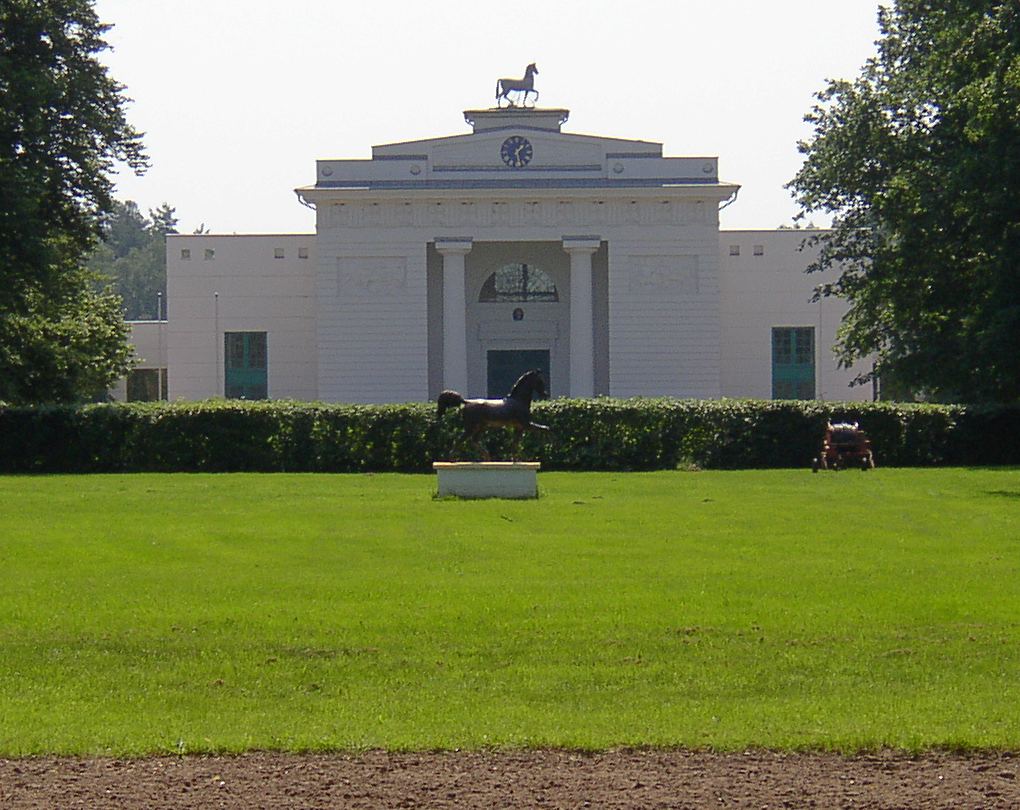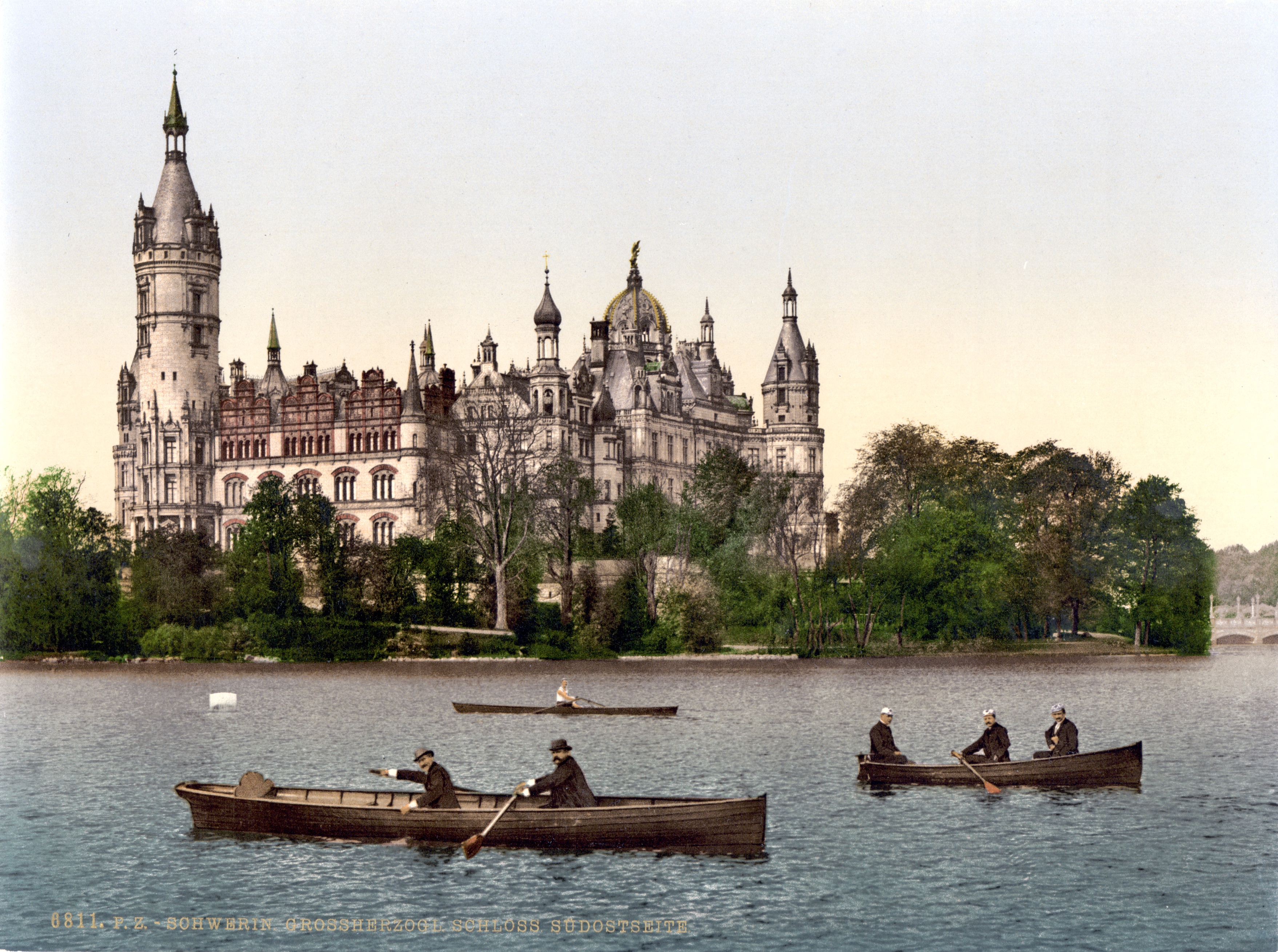|
Mecklenburger
The Mecklenburger is a warmblood horse bred in the Mecklenburg-Vorpommern region of north-eastern Germany. The breeding of these horses has been closely linked to the State Stud of Redefin. Historically influenced by Arabian (horse), Arabian and Thoroughbred blood, today's Mecklenburger is an athletic riding and driving horse similar to the neighboring Hanoverian (horse), Hanoverian. They are bred to the same standards as the other German Warmbloods, and are especially suitable for dressage and show jumping, though they are used for combined driving, eventing and show hunter competition as well. History The region today known as Mecklenburg-Vorpommern was, until 1934, composed of the duchies of Duchy of Mecklenburg-Schwerin, Mecklenburg-Schwerin and Duchy of Mecklenburg-Strelitz, Mecklenburg-Strelitz. However, the region was united by virtue of being under the rule of the House of Mecklenburg, so the histories of Schwerin, Strelitz and the other Mecklenburg duchies are in ... [...More Info...] [...Related Items...] OR: [Wikipedia] [Google] [Baidu] |
Warmblood
Warmbloods are a group of middle-weight horse types and breeds primarily originating in Europe and registered with organizations that are characterized by open studbook policy, studbook selection, and the aim of breeding for equestrian sport. The term distinguishes these horses from both heavy draft horses ("cold bloods") and refined light saddle horses such as the Thoroughbred, Arabian, and Akhal-Teke ("hot bloods"). Although modern warmbloods are descended from heavier agricultural types systematically upgraded by hotblood influence, the term does not imply that warmbloods are direct crosses of "cold" and "hot". Breeding policies Open studbook policies separate most warmbloods from true "breeds" such as Thoroughbreds, Arabians, Percherons, and Morgans which have a closed stud book and require two purebred parents. Instead, most warmblood registries accept breeding stock from other similar populations to continuously improve their own, and do not consider their own ... [...More Info...] [...Related Items...] OR: [Wikipedia] [Google] [Baidu] |
Celle State Stud
Celle State Stud is a state-owned facility for horse breeding in Celle, Germany. The State Stud of Celle, located in what is now known as Lower Saxony, was founded in 1735 by order of George II, King of Great Britain, Elector of Hanover and Duke of Brunswick-Lüneburg. Its purpose was to make high-quality stallions available to local breeders. Several wars affected not only the safety of the horses, but the types of stallions housed there. Celle's history is intertwined with the history of the Hanoverian horse breed, but the breed registry is privately owned and is an entity independent of the stud. Today the state stud is known for its annual stallion parades. History The Lower Saxony State Stud of Celle was founded on July 27, 1735. Celle's foundation is unique among the state studs of Germany, because it was not originally based on a royal stud or courtly stables. It was established by the decree of King George II of Great Britain, also the Elector of Hanover and Duke of B ... [...More Info...] [...Related Items...] OR: [Wikipedia] [Google] [Baidu] |
Hanoverian (horse)
A Hanoverian (German: ''Hannoveraner'') is a Warmblood horse breed originating in Germany, which is often seen in the Olympic Games and other competitive English riding styles, and has won gold medals in all three equestrian Olympic competitions. It is one of the oldest, most numerous, and most successful of the Warmblood breeds. Originally a cavalry horse, infusions of more Thoroughbred blood lightened it to make it more agile and useful for competition. The Hanoverian is known for a good temperament, athleticism, beauty, and grace. Breed history In 1735, George II, the King of England and Elector of Hanover, founded the State Stud at Celle. He purchased stallions suitable for all-purpose work in agriculture and in harness, as well as for breeding cavalry mounts. The local mares were refined with Holsteiner, Thoroughbred and Cleveland Bay, Neapolitan, Andalusian, Prussian, and Mecklenburg stock. By the end of the 18th century, the Hanoverian had become a high-clas ... [...More Info...] [...Related Items...] OR: [Wikipedia] [Google] [Baidu] |
Germany
Germany, officially the Federal Republic of Germany (FRG),, is a country in Central Europe. It is the most populous member state of the European Union. Germany lies between the Baltic and North Sea to the north and the Alps to the south. Its 16 constituent states have a total population of over 84 million in an area of . It borders Denmark to the north, Poland and Czechia to the east, Austria and Switzerland to the south, and France, Luxembourg, Belgium, and the Netherlands to the west. The nation's capital and most populous city is Berlin and its main financial centre is Frankfurt; the largest urban area is the Ruhr. Settlement in what is now Germany began in the Lower Paleolithic, with various tribes inhabiting it from the Neolithic onward, chiefly the Celts. Various Germanic tribes have inhabited the northern parts of modern Germany since classical antiquity. A region named Germania was documented before AD 100. In 962, the Kingdom of Germany formed the ... [...More Info...] [...Related Items...] OR: [Wikipedia] [Google] [Baidu] |
Redefin
Redefin is a municipality in the Ludwigslust-Parchim district, in Mecklenburg-Vorpommern, Germany. Redefin is mostly known because of the state stud farm (Landgestüt) of Mecklenburg-Vorpommern, which was founded in 1812. References Ludwigslust-Parchim {{LudwigslustParchim-geo-stub ... [...More Info...] [...Related Items...] OR: [Wikipedia] [Google] [Baidu] |
Grand Duchy Of Mecklenburg-Schwerin
The Grand Duchy of Mecklenburg-Schwerin was a territory in Northern Germany held by the House of Mecklenburg residing at Schwerin. It was a sovereign member state of the German Confederation and became a federated state of the North German Confederation and finally of the German Empire in 1871. Geography Like its predecessor, the Duchy of Mecklenburg-Schwerin, the Schwerin lands upon the incorporation of the extinct Duchy of Mecklenburg-Güstrow in 1701 comprised the larger central and western parts of the historic Mecklenburg region. The smaller southeastern part was held by the Duchy of Mecklenburg-Strelitz branch of the grand ducal house, who also ruled over the lands of the former Bishopric of Ratzeburg in the far northwest. The grand duchy was bounded by the Baltic coast in the north and the Prussian province of Pomerania in the northeast, where the border with the Hither Pomeranian (formerly Swedish Pomeranian) region ran along the Recknitz river, the Peene, an ... [...More Info...] [...Related Items...] OR: [Wikipedia] [Google] [Baidu] |
Bad Doberan
Bad Doberan () is a town in the district of Rostock, Mecklenburg-Vorpommern, Germany. It was the capital of the former district of Bad Doberan. In 2012, its population was 11,427. Geography Bad Doberan is situated just west of Rostock's city centre and is therefore part of one of the most developed regions in the north-eastern part of Germany. The town nestles between beautiful beech tree forests just 6 km from the Baltic Sea and is one of the earliest German settlements in Mecklenburg. Today the town is a very popular bathing resort, thanks to Heiligendamm, a district of Bad Doberan situated directly at the cliff line of the Baltic. Historically, Doberan used to be the summer residence for the Mecklenburg Dukes who resided in Schwerin, and for their entourage. Name The name Doberan, originally ''Dobran'', is a place name that probably derives from a Slavic Old Polabian personal name, meaning "good" (''dobry''). According to legend, the name Doberan originated when the ... [...More Info...] [...Related Items...] OR: [Wikipedia] [Google] [Baidu] |
Turkoman Horse
The Turkoman horse, or Turkmene, was an Oriental horse breed from the steppes of Turkoman desert. Its closest modern descendant is thought to be the Akhal-Teke. It influenced many modern horse breeds, including the Thoroughbred horse. Some horses bred in Iran and Turkmenistan today are still referred to as Turkoman, and have similar characteristics. Modern descendants include the Akhal-Teke, the Iomud (''also called'' Yamud or Yomud), the Goklan and Nokhorli. Characteristics The Turkoman horse was noted for its endurance. It had a slender body, similar to a greyhound. Although refined in appearance, the breed was actually one of the toughest in the world. They had a straight profile, long neck, and sloping shoulders. Their back was long, with sloping quarters and tucked-up abdomen. They had long and muscular legs. The horses ranged from 15–16 hands. The Turkoman and the Arabian compared Though both the Arabian horse and the Turkoman may have had a common ancestor in ... [...More Info...] [...Related Items...] OR: [Wikipedia] [Google] [Baidu] |
Arabian Horse
The Arabian or Arab horse ( ar, الحصان العربي , DMG ''ḥiṣān ʿarabī'') is a breed of horse that originated on the Arabian Peninsula. With a distinctive head shape and high tail carriage, the Arabian is one of the most easily recognizable horse breeds in the world. It is also one of the oldest breeds, with archaeological evidence of horses in the Middle East that resemble modern Arabians dating back 4,500 years. Throughout history, Arabian horses have spread around the world by both war and trade, used to improve other breeds by adding speed, refinement, endurance, and strong bone. Today, Arabian bloodlines are found in almost every modern breed of riding horse. The Arabian developed in a desert climate and was prized by the nomadic Bedouin people, often being brought inside the family tent for shelter and protection from theft. Selective breeding for traits, including an ability to form a cooperative relationship with humans, created a horse breed that ... [...More Info...] [...Related Items...] OR: [Wikipedia] [Google] [Baidu] |
Hahn (nobility)
The House of Hahn (originally Hane and Hanen) is an ancient German-Baltic noble family which was prominent in the Duchy of Courland and Semigallia and on the Baltic Island Ösel. It was founded in 1230. It is also part of the old Mecklenburg noble family, first mentioned on October 30th, 1230. The Mecklenburg clan branched out at the turn of the 14th century into a Mecklenburg and a Courland clan. Later, the family carried the title Baron or Baron (Baroness, Baroness, Freifrau, Freiin). Ludolf Hahn (around 1300) is mentioned as the ancestor of the Baltic lines, whose descendants later established their residence with Heinrich von Hahn (around 1518) in Postenden near Talsen. Johann August von Hahn (around 1725 - 1799) descended from the Saaremaa von Hahns. Both family lines carried the same coat of arms. Origins The origin of the name and the family is not clear. The first Hahn, with whom this coat of arms is associated, is mentioned in the historical annals as Eckhard I, or "E ... [...More Info...] [...Related Items...] OR: [Wikipedia] [Google] [Baidu] |
Bassewitz
The House of Bassewitz is a German family of ancient nobility whose roots come from the Mecklenburg region. According to tradition, the family was named after the village of ''Basse'' (now a district of the municipality of Lühburg). In German hunter-language, ''Basse'' refers to a tusker or adult male wild boar. A Tusker Courant is the family's heraldic animal. History Earliest references to the family include a document from 1254 in which ''Bernhardus de Bassewicze'' is mentioned. Another document from 1308 mentions ''Heinrich von Bassewitz''. It is unknown whether the family was among the German families immigrating the Mecklenburg region since the 12th century in the course of the German eastward expansion or whether the Bassewitz family was of Slavic origin. Slavic tribes (the Wends) settled in the area since the 7th century. At the time of colonization, German families took the name of the place where they settled as their surname, while at the same time, Wendish fami ... [...More Info...] [...Related Items...] OR: [Wikipedia] [Google] [Baidu] |






